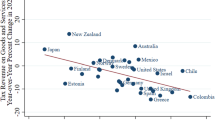Abstract
I analyze the choice politicians face when seeking votes from groups that lobby for sales tax rate decreases or tax exemptions, given the constraint that politicians want to raise a certain amount of revenue. Using data on sales taxes, I develop a model predicting a positive relationship between the number of exemptions and the sales tax rate. The estimation results provide support for this prediction. Each additional exemption is associated with an increase of between 0.10 and 0.25 percentage points in the tax rate.



Similar content being viewed by others
Notes
To test this hypothesis, I assume that cross-border shopping or any online shopping that might give rise to an erosion of tax and exemption differences across states is quantitative small, relative to all sales within the state.
The states are: Arkansas, Georgia, Indiana, Iowa, Kansas, Kentucky, Michigan, Minnesota, Nebraska, Nevada, New Jersey, North Carolina, North Dakota, Ohio, Oklahoma, Rhode Island, South Dakota, Tennessee, Utah, Vermont, Washington, West Virginia, Wisconsin, and Wyoming.
I chose 2009 for revenue data because it falls within the 2008-to-2012 period, for which I have data on sales tax exemptions. Owing to recessionary conditions in that time frame, sales tax revenues might have been below average; however, if the revenue reduction was similar across all states, it should not affect my estimates of the equilibrium relationship between sales tax rates and exemptions.
I kept Colorado in the sample because if politicians there decide to reduce the number of sales tax exemptions, they are unable to raise sales tax rates to offset the narrower sales tax base. The constitutional constraint on raising the state sales tax rate may lead to less significant results if exemptions are reduced, and the sales tax cannot be raised.
Tax Facts 96-1, General Excise vs. Sales Tax http://www6.hawaii.gov/tax/taxfacts/tf96-01.pdf.
Sales tax rates are from 2012, while data on exemptions come primarily from earlier years, starting with 2008. This fact mitigates concerns that the error term in Eq. (1) is correlated with exemptions.
This is done because California has the highest sales tax rate in the United States and allows one of the largest number of exemptions.
References
Anderson, G. M., Martin, D. T., & Tollison, R. D. (1987). Do tax loopholes increase or decrease tax revenue? Journal of Public Finance and Public Choice, 5, 83–95.
Besley, T. J., & Rosen, H. S. (1998). Sales taxes and prices: an empirical analysis. NBER Working Paper No. 6667. National Bureau of Economic Research.
Brownell, K. D., Farley, T., Willett, W. C., Popkin, B. M., Chaloupka, F. J., Thompson, J. W., et al. (2009). The public health and economic benefits of taxing sugar-sweetened beverages. The New England Journal of Medicine, 361(16), 1599–1605.
Bruce, D., Fox, W. F., & Tuttle, M. (2006). Tax base elasticities: A multi-state analysis of long-run and short-run dynamics. Southern Economic Journal, 73(2), 315–341.
Chouinard, H. H., Davis, D. E., LaFrance, J. T., & Perloff, J. M. (2006). Fat taxes: big money for small change. Working Paper No. 1007. Department of Agricultural and Resource Economics and Policy, University of California at Berkeley.
Hall, B. H. (1999). Effectiveness of the California R&D credit. California Council on Science and Technology. http://www.ccst.us/publications/1999/CREST4.pdf.
Hansmann, H. (1987). The effect of tax exemption and other factors on the market share of non-profit versus for-profit firms. National Tax Journal, 40, 71–82.
Hawkins, R. R. (2002). Popular substitution effects: excess burden estimates for general sales taxes. National Tax Journal, 55(4), 755–770.
Ihlanfeldt, K. R. (1995). Ten principles for state tax incentives. Economic Development Quarterly, 15, 339–355.
Militaru, A. & Stratmann T. (2014). A Survey of Sales Tax Exemptions in the States: Understanding Sales Taxes and Sales Tax Exemptions Working Paper No. 14, Mercatus Center at George Mason University.
Peltzman, S. (1976). Toward a more general theory of regulation. Journal of Law and Economics, 19, 211–240.
Powell, L. M., & Chaloupka, F. J. (2009). Food prices and obesity: evidence and policy implications for taxes and subsidies. The Milbank Quarterly, 87(1), 229–257.
Stigler, G. J. (1971). The theory of economic regulation. The Bell Journal of Economics and Management Science, 2(1), 3–21.
Acknowledgements
This paper is based on a my co-authored working paper with (Militaru and Stratmann 2014).
Author information
Authors and Affiliations
Corresponding author
Electronic supplementary material
Below is the link to the electronic supplementary material.
Rights and permissions
About this article
Cite this article
Stratmann, T. The political economy of sales taxes and sales tax exemptions. Public Choice 171, 207–221 (2017). https://doi.org/10.1007/s11127-017-0434-z
Received:
Accepted:
Published:
Issue Date:
DOI: https://doi.org/10.1007/s11127-017-0434-z




